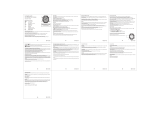1:8
ALTIMETER > ALTITUDE DIFFERENCE
Altitude difference
display
Sequentially every 2 seconds
Elapsed time or stopped time Total cumulative gain in altitude
during elapsed time
Mean vertical speed of ascent
(metres/minute or feet/minute)
Total cumulative loss in altitude
during elapsed time
Mean vertical speed of descent
(metres/minute or feet/minute)
Back: Elapsed time or stopped time
1188A
03:18h55
03:18h55
18A5
03:18h55
3192d
24d5
03:18h55
2 sec. 2 sec.
2 sec. 2 sec.2 sec.
Start Altitude difference meter Stop Altitude difference meter Reset Altitude difference meter
00:00h00
R
03:18h55
R
00:00h00
00:00h00
rESET
03:18h55
STOP
R
00:00h00
rUn
R
m
2 sec.
We advise you to stop the altitude difference meter during rest times and then
restart it, in order to obtain more accurate results.
Note 1: "Presetting" an altimeter means setting
the actual altitude of a known point (see preset-
ting procedure on page 7). The actual altitude
values are indicated on various media: signposts,
contour lines and spot heights on maps. The al-
titude "presetting" is in line with relative atmos-
pheric pressure.
Note 2: In an airliner, since the cabin is pressurised, your altimeter will not
indicate an accurate altitude.
Note 3: To optimise the accuracy of your altimeter, you are advised to select
the climate zone, see page 5.
Characteristics of function
Description of function
In altimeter mode, your T-TOUCH becomes a baro-
metric altimeter, displaying the altitude relative to
mean sea level.
Explanations
This is a barometric instrument, which calculates
the altitude as a function of absolute pressure
(atmospheric). As the altitude rises, pressure
drops, and vice versa. So the altimeter measures
the difference between absolute pressure (atmos-
pheric) and relative pressure (relative to sea level) to display the altitude. Your
T-TOUCH is temperature compensated, and you can adjust your geographic
location (hemisphere and climate zone). The altitude displayed is therefore cor-
rected automatically.
This makes it the ideal instrument for measuring vertical movement with the
altitude difference function (e.g. in mountain trekking). The altitude difference
meter indicates the elapsed time, cumulative gains and losses in altitude and
mean vertical speeds of ascent and descent.
GLOSSARY > ALTIMETER
0m
500m
1000m
1500m
2000m
792M
R
540 m
780 m
540 m
Measurement range – 400 m to +9000 m – 1333 ft to +30,000 ft
Altimeter resolution 1 m 3 ft
Unit conversion
1 metre [m] =
3.281 feet [ft]
1 foot [ft] =
0.305 metres [m]
Altitude difference meter
max. measurement time
9 days 23 hours 59 minutes
Maximum altitude difference +/- 30,000 m +/- 99,000 ft
Altitude difference meter
resolution
1 m 3 ft
Maximum vertical speed
4999 m/min
(appr. 300 km/h)
16,401 ft/min
(appr. 187.5 mph)
Minimum vertical speed 5 m/min (appr. 0.3 km/h) 16.4 ft/min (appr. 0.2 mph)
Vertical speed resolution 1 m/min 3 ft/min
Minimum vertical movement 5 m 16 ft
Minimum time of movement 5 mins
NB!
Due to the use of pressure to calculate altitude, the altimeter is sensitive to
variations in atmospheric pressure in weather changes. It is not uncommon
to observe altitude differences of 100 m in a night. So the value displayed
may vary without the altitude having actually changed.
4000M 4478M 5000M
Weather change = pressure variation = displayed altitude change
4473 m 4473 m 4473 m
4478m
m















